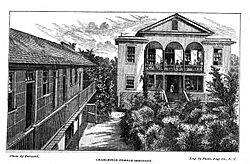Charleston Female Seminary facts for kids
Quick facts for kids Charleston Female Seminary |
|
|---|---|

Charleston Female Seminary at its Philip Street location
|
|
| Location | |
|
,
|
|
| Information | |
| Type | Private, All-Female |
| Motto | Mens sana in corpore sano ("A sound mind in a sound body.") |
| Religious affiliation(s) | Christian |
| Established | 1870 |
| Founder | Henrietta "Etta" Aiken Kelly |
The Charleston Female Seminary, also known as Miss Kelly's School, was a private Christian school for girls from well-off families in Charleston, South Carolina. It was a place where young women could get a strong education.
Contents
History of the Charleston Female Seminary
Who Started Miss Kelly's School?
The Charleston Female Seminary opened in 1870. It was started by a woman named Henrietta "Etta" Aiken Kelly (1844–1916). She first taught students right in her own home. Miss Kelly was very smart and even knew a lot about silk worms!
Why Was the School Created?
Before starting her own school, Miss Kelly tried to get female students accepted into the College of Charleston. When that didn't work, she decided to create her own school. Her goal was to give girls a chance to get a higher education, similar to what young men received.
Where Was the School Located?
In 1872, the school moved to a special building at 50 Philip Street. This building was designed in 1871 by an architect named John Henry Devereux. It had a unique "mixed Roman" Italianate style with fancy arches and a front design that stood out.
Later, in the 1890s, the school moved again. It was located at the Benjamin Lazarus House on 151 Wentworth Street. A third floor was even added to this building. After that, it moved to a place that is now known as the Nathaniel Russell House at 51 Meeting Street.
What Was the School's Motto?
Miss Kelly ran the school with the motto Mens sana in corpore sano. This means "A sound mind in a sound body." This motto showed that she believed in educating both the brain and the body. She made sure that physical education was a part of the school's lessons.
Why Were Female Seminaries Important?
A New Trend in Education for Girls
The creation of female seminaries like Miss Kelly's was a big trend across the United States. These schools were part of a growing movement for women's equality. Around the 1800s, many people started to believe that girls should have more opportunities.
Advanced Learning in the South
Southern female seminaries were actually some of the most advanced in the country. They offered programs that were like four-year college degrees, even before the American Civil War. This was a new and exciting time for women's education. Going to a well-known seminary gave girls not only knowledge but also a good standing in society.
How Schools for Girls Changed Over Time
The Charleston Female Seminary changed over the years, just like other schools for girls. They started in homes or small boarding schools. But over time, they grew into larger, more formal institutions. These bigger buildings had dorms, chapels, dining halls, and classrooms. The Charleston Female Seminary opening in 1870 was important because after the Civil War, it was harder for new schools for girls to start.
Another school for girls in Charleston was Miss Murden's Seminary for Young Ladies.
Notable Students of Charleston Female Seminary
Many talented young women attended the Charleston Female Seminary. Here are a few who became well-known:
- Beatrice Witte Ravenel (1870–1956) was a famous author. Her daughter, Beatrice St. Julien Ravenel, also became a well-known writer about architecture in South Carolina.
- Hermine Kean Bulwinkle (1868–1942) later became a faculty member at Gaston College in North Carolina.
- Sarah Campbell Allan (1861–1954) became a physician. This was a huge achievement because it was very difficult for women to become doctors back then. She studied medicine in New York and was licensed in South Carolina in 1894. She was the only woman to take the medical board exam that year and got the highest score! Dr. Allan worked at a hospital in Columbia and taught anatomy to nursing students for 11 years.
- Sarah Visanska graduated in 1889. She later became the president of the South Carolina Federation of Women's Clubs from 1910 to 1912.
- Louise Hammond Willis Snead was a writer, lecturer, and artist. She was a student at the seminary and also taught painting and drawing classes there.
Images for kids


